Does Food Structure Affect Satiety?
Published on 26 March 2013 in Food, health and wellbeing

Introduction
With the developments in food technology in recent decades there has been a major shift in the type of food consumed with more ready meals, processed food and high energy drinks consumed displacing natural and unprocessed food sources. The amount of calories consumed as processed foods, which are often high in energy and low in fibre and available in a variety of forms, may depend upon the physical form in which the food is presented. Rate of consumption is often greater if the food is available in a liquid format. This has the potential to result in a higher rate of energy intake and therefore contribute to the current obesity epidemic facing Scotland, the UK and many other countries, which is fundamentally driven by over-consumption of calories. Stemming the tide of the obesity epidemic is of high priority as obesity is a major factor behind conditions such as diabetes, cardiovascular disease and various cancers.
One approach to sustainably reducing food consumption is to increase the feeling of fullness (satiation/satiety) from food we eat. There is some evidence that certain major components of food (macronutrients - protein, carbohydrate, fat and fibre) are better than others at inducing satiety. This evidence is usually derived from the presentation of macronutrients in a solid form but we have little information on what effect the same food presented in a different form, e.g. as a liquid, may have on its ability to induce satiety. Such information is important for novel product development and reformulation of existing products aimed at consumers in the competitive retail market place.
Key Points
Food presented as a liquid is often consumed at a greater rate or amount than solid food.
Research Undertaken
Work is be undertaken at RINH to investigate what effect a complex food presented in either a solid or a liquid form has on the induction of satiety in an animal model and humans. Comparison is being made of diets high in carbohydrate, high in protein or high in fat for their ability to induce secretion of gut hormones and their ability to activate satiety pathways in the brain. Further work will test whether the form in which a diet is presented affects the satiety properties of the food and thereby influences the timing of the next bout of food intake. This work is complemented by research projects using cell lines to investigate the effect of individual nutrients on gut hormone release via specific nutrient receptors.
Policy Implications
These studies will provide an initial evidence base as to whether the same food presented in contrasting physical formats is able induce satiation equally as a solid or a liquid, whether satiety is long lasting and whether there is an impact on body fat stores. This information may be useful in providing dietary advice for weight maintenance or loss and provide a useful indicator to the food industry in the development of new consumer products.
Authors
Dr Perry Barrett P.Barrett@abdn.ac.uk
Dr Alexandra Johnstone Alex.Johnstone@abdn.ac.uk





